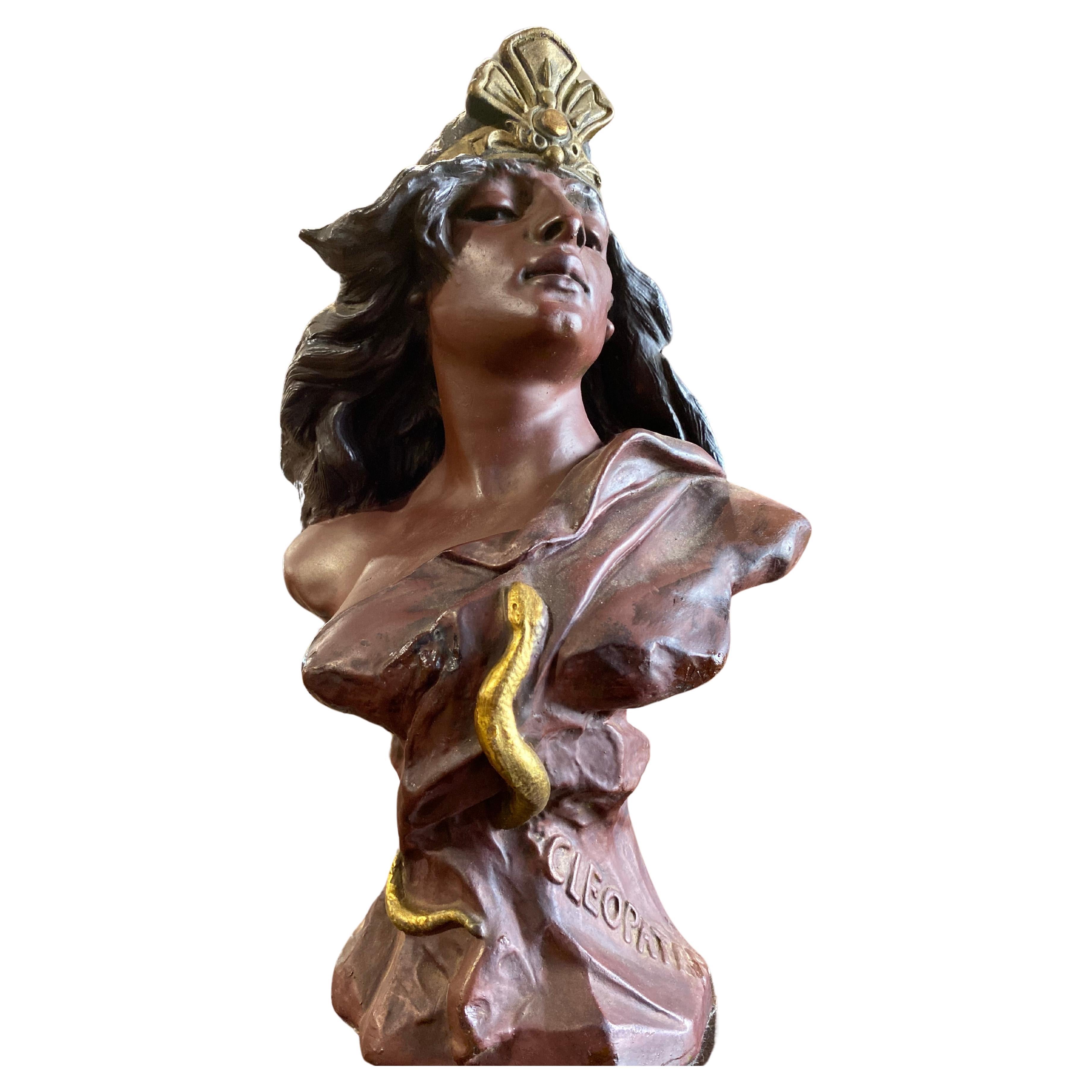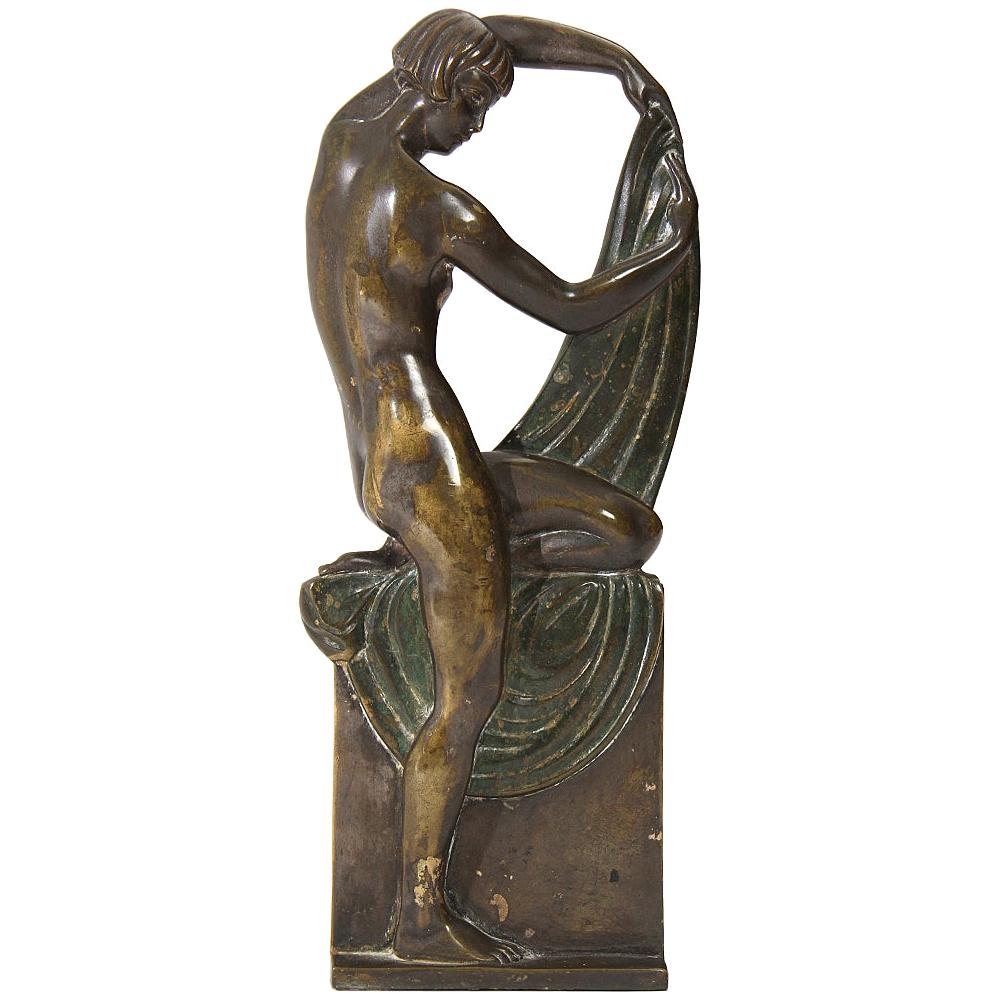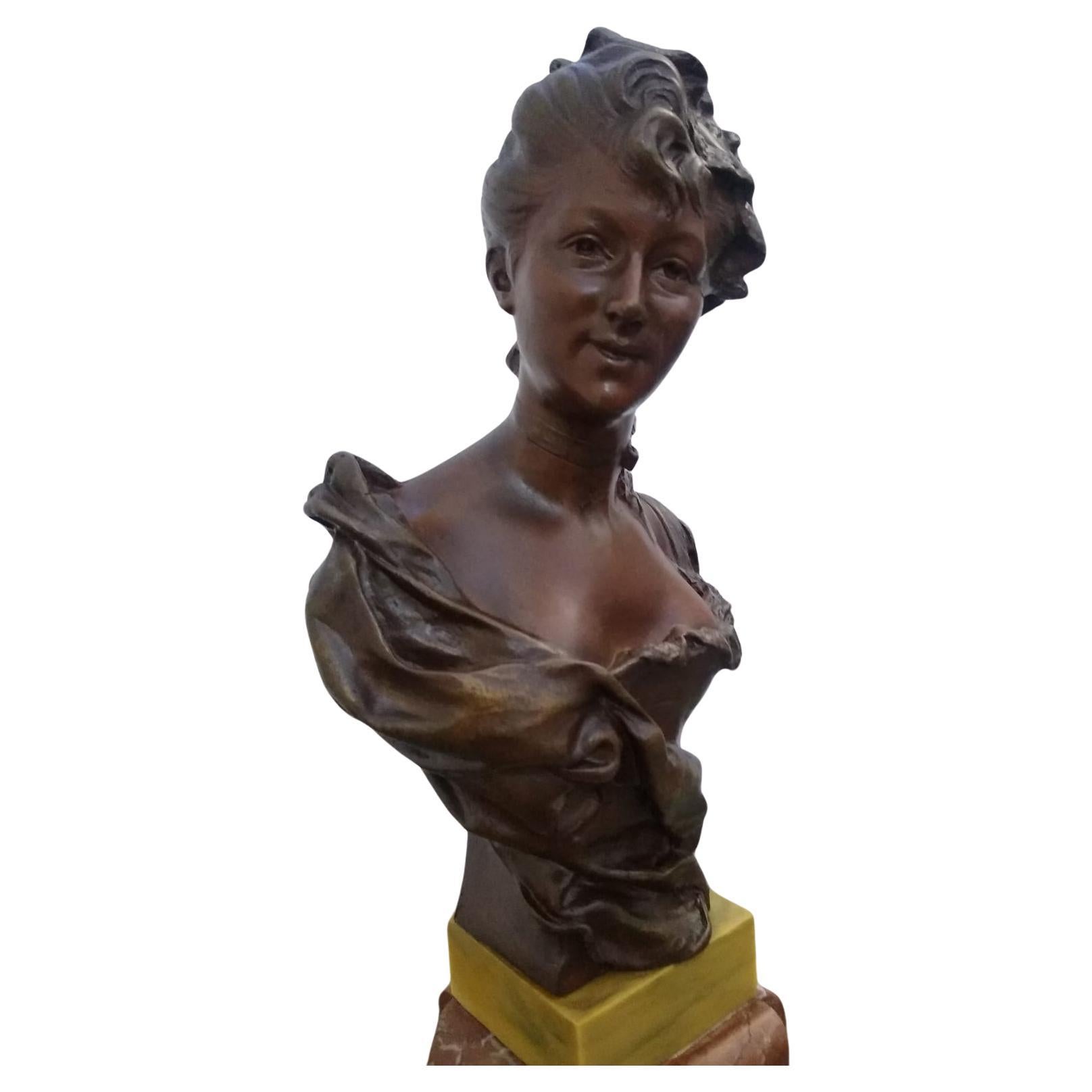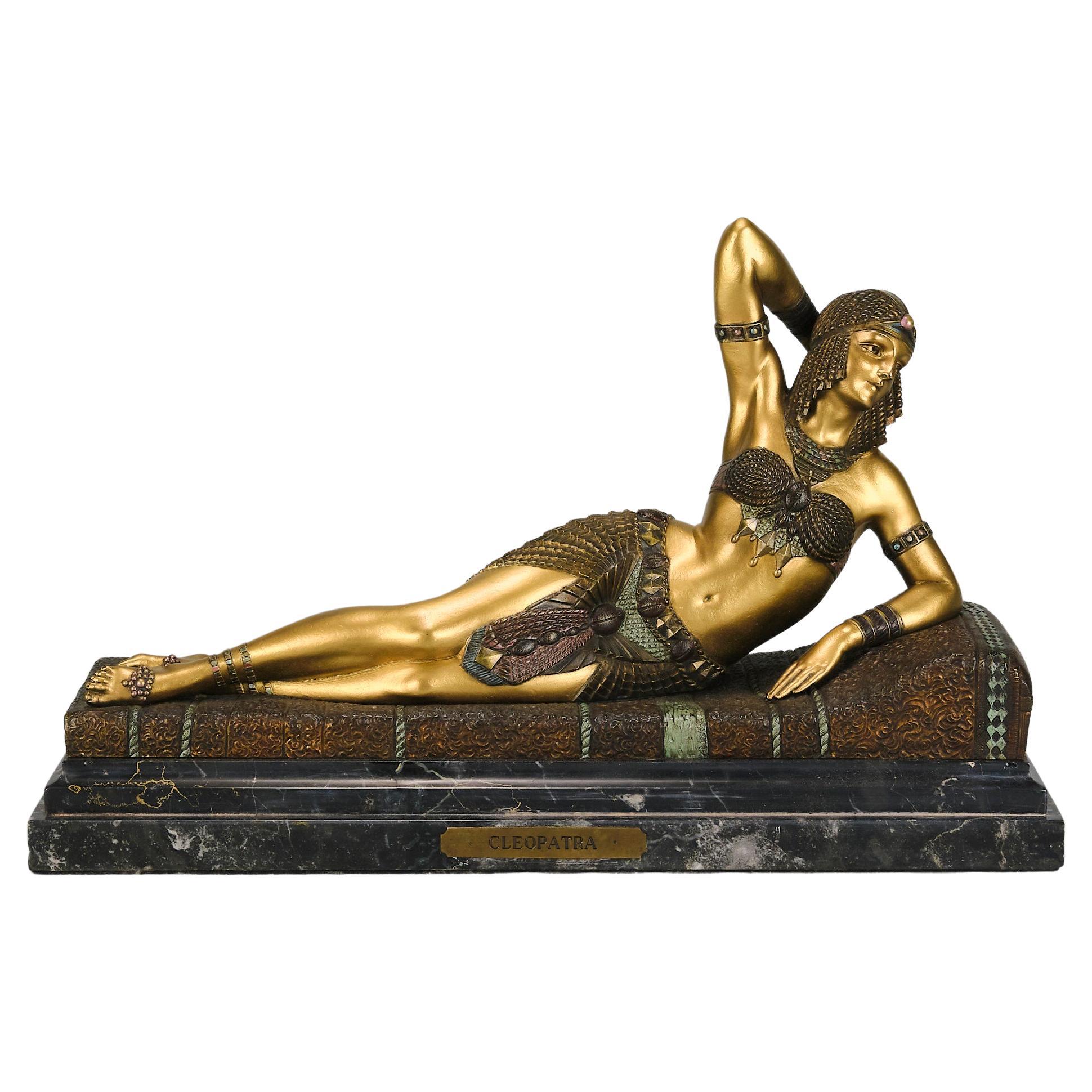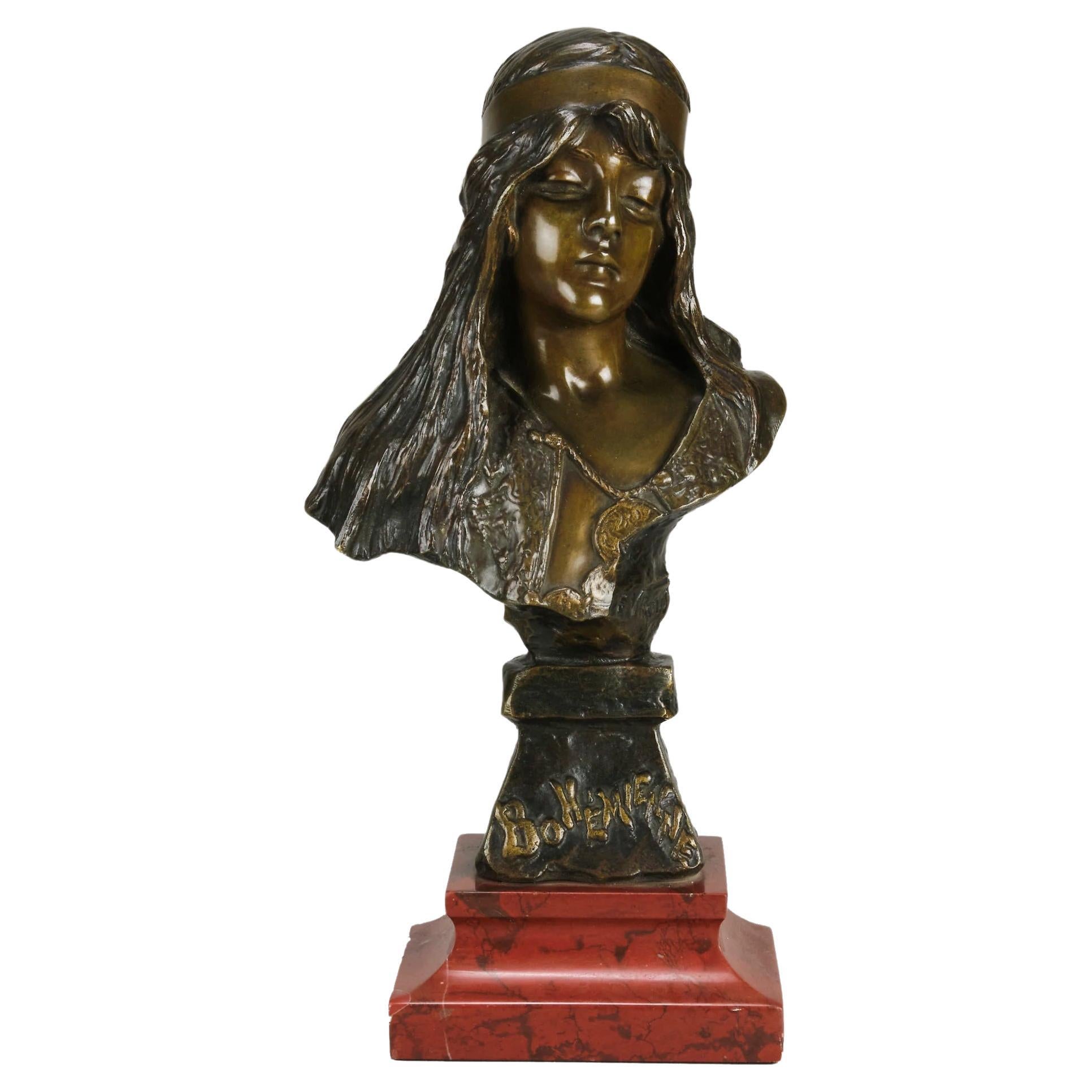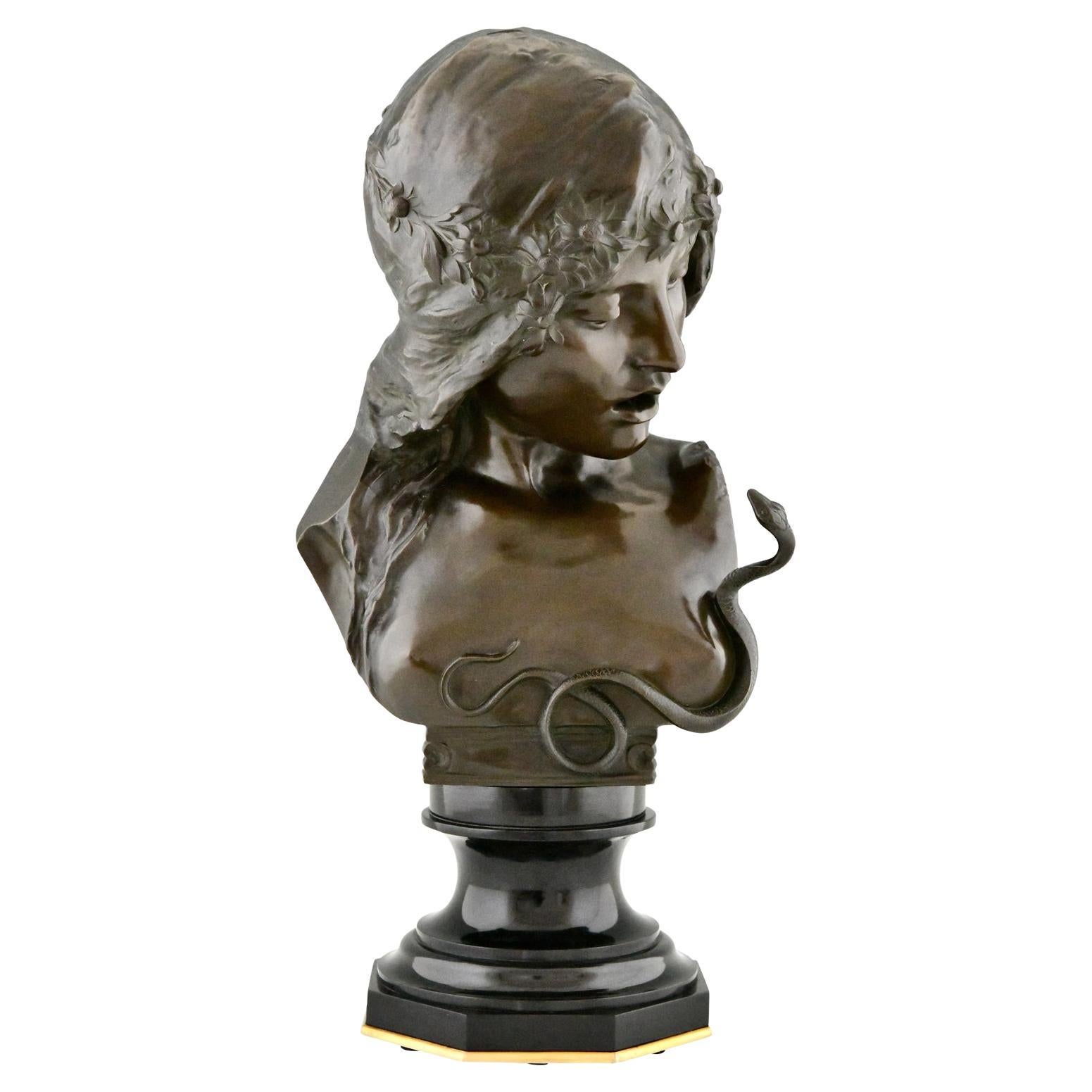Items Similar to Art Nouveau Bronze Sculpture Entitled "Cleopatra and Asp" by Schnauder
Want more images or videos?
Request additional images or videos from the seller
1 of 11
Art Nouveau Bronze Sculpture Entitled "Cleopatra and Asp" by Schnauder
About the Item
A very fine early 20th Century gilt bronze figure of the famous Cleopatra with a snake wrapped around her wrist drinking from a bowl. Exhibiting fine colour and excellent hand finished surface detail raised on a shaped base, signed Schnauder
ADDITIONAL INFORMATION
Height: 39 cm
Condition: Excellent Original Condition
Circa: 1910
Materials: Gilt Bronze
Book Ref Art Deco and Other Figures by Bryan Catley
SKU: 8655
ABOUT
Rheinhard Schnauder - German 1856 ~ 1923
A German sculptor working in the late 19th/early 20th Century Schnauder was the son of a draughtsman, Franz Julius, and trained at the Art Academy in Dresden and later in Hahnel's studio. He is known for his sculptures in the Art Nouveau manner and worked on the decoration of the Gorlitz Memorial Hall.
- Creator:Richard Georg Schnauder (Artist)
- Dimensions:Height: 15.36 in (39 cm)Width: 0 in (0.01 mm)Depth: 0 in (0.01 mm)
- Style:Art Nouveau (Of the Period)
- Materials and Techniques:
- Place of Origin:
- Period:
- Date of Manufacture:1910
- Condition:Wear consistent with age and use.
- Seller Location:London, GB
- Reference Number:
About the Seller
5.0
Gold Seller
These expertly vetted sellers are highly rated and consistently exceed customer expectations.
Established in 1936
1stDibs seller since 2017
64 sales on 1stDibs
Typical response time: 1 hour
- ShippingRetrieving quote...Ships From: London, United Kingdom
- Return PolicyA return for this item may be initiated within 10 days of delivery.
More From This SellerView All
- Early 20th Century Bronze Entitled "Cleopatra" by Demetre ChiparusBy Demetre ChiparusLocated in London, GBA dramatic early 20th century Art Deco cold painted gilt bronze figure of the reclining Cleopatra in full Ballets Russes costume, raised on a fitt...Category
Early 20th Century French Art Deco Figurative Sculptures
MaterialsMarble, Bronze
- 19th Century Art Nouveau Bronze Bust Entitled "Bohémienne" by Emmanuel VillanisBy Emmanuel VillanisLocated in London, GBCaptivating late 19th century French bronze bust of a beautiful woman, enhanced by the variegated rich brown patination and excellent tactile surface detail, raised on an integral bronze base with raised title to the fore. Signed ?E Villanis and further raised on a breche griotte stepped and shaped marble plinth ADDITIONAL INFORMATION Height: 33 cm Width: 16 cm Depth: 11 cm Condition: Excellent Original Condition circa: 1890 Materials: Bronze Book Ref: Emmanuel Villanis by Josje Hortulanus-de Mik Page No: 17 SKU: 8616 ABOUT Puccini's Opera - La Bohème SYNOPSIS - A group of friends are living a Bohemian life in Paris and trying to make their livings creating art. Rodolfo, the writer, falls in love with the seamstress, Mimi, while Marcello, the painter, and Musetta, the singer, are the on-and-off-again couple by their sides. When the four are happy, they spend their time celebrating life and love. However, Mimi is revealed to be very ill, and Rodolfo struggles to come to terms with the fact that she will inevitably die. Rodolfo and Mimi break up, and months later, Musetta discovers Mimi extremely sick and close to death. She brings Mimi to Rodolfo and Marcello's apartment. Rodolfo immediately takes her in and tries to nurse her back to health, but he is too late. Almost as soon as the two are reunited and have professed their love for one another, Mimi succumbs to her illness and dies. Emmanuel Villanis Emmanuel Villanis was an industrious man. He is believed to have created some 200 to 250 pieces. His oeuvre pre-eminently consisted of busts and full body statues. Most of these were manufactured in bronze, but there are also models in white metal and terra cotta. Different patinas were used. The bronzes were mainly cast by the Societé de Bronzes de Paris and can be recognised by the round stamp...Category
Antique Late 19th Century French Art Nouveau Busts
MaterialsMarble, Bronze
- Early 20th Century Art Nouveau Bronze Entitled "La Jeuneuse" by Antonin CarlèsBy Antonin CarlèsLocated in London, GBA delightful Art Nouveau early 20th Century gilt bronze figure of a very beautiful young lady holding a flower in her right hand, the surface of the bronze exhibiting fine detail and...Category
Antique Early 1900s French Art Nouveau Figurative Sculptures
MaterialsBronze
- Early 20th Centrury French Bronze Entitled Art Nouveau Bust by Alexandre CaronBy A. CaronLocated in London, GBAn excellent French early 20th Century Art Nouveau bronze bust of a beautiful young woman waering an off the shoulder blouse. Raised on a slend...Category
Antique Early 1900s French Art Nouveau Busts
MaterialsBronze
- Late 19th Century Art Nouveau Bronze Entitled "Broken Jug" by Charles AnfrieBy Charles AnfrieLocated in London, GBA very fine late 19th century bronze figure of a young lad dressed in period attire holding a broken jug, with excellent rich brown patina and fabulous hand finished surface detail, signed & titled ADDITIONAL INFORMATION Height: 20 cm Condition: excellent original condition Circa: 1890 Materials: Bronze SKU: 8279 ABOUT Charles Anfrie...Category
Antique 1890s French Art Nouveau Figurative Sculptures
MaterialsBronze
- 19th Century Art Nouveau Bronze Entitled "Venus & Cupid" by Jean Sul-AbadieBy Jean AbadieLocated in London, GBA very fine bronze study of Venus taking an arrow from Cupid her son, who at times would shoot his arrows without meaning or reason into the hearts of men, igniting their desire. Exhibiting excellent rich brown patina and good detail, signed Sul Abadie and stamped. Additional information Height: 93 cm Condition: excellent condition Circa: 1885 Materials: bronze & marble SKU: 4979 ABOUT Jean Sul-Abadie Jean Sul-Abadie (Born 1850 ~ Died 15th April 1890) was a French artist, a pupil of Jouffroy and Falguière. Specialising in bronze sculpting in the Art Nouveau style. He made his Salon debut in 1872. Cupid & Venus Different tales exist about the origin of Venus and Cupid. Some say that Venus, the goddess of love and beauty, had a love affair with Mars, the god of war. Out of this relationship, Cupid was born. In the following painting you see Venus with Mars, who is being disarmed by Cupid. Cupid has attributes from both of his parents. Like his mother he is considered to be the god of love, or more precisely, the god of falling in love. He is portrayed as an innocent little child with bow and arrows. He shoots arrows to the heart, and awakening a love that you’re powerless to resist. In classical mythology, Cupid (Latin Cupido, meaning “desire”) is the god of desire, erotic love, attraction and affection. He is often portrayed as the son of the love goddess Venus and the war god Mars, and is known in Latin also as Amor (“Love”). His Greek counterpart is Eros. Although Eros is in Classical Greek art as a slender winged youth, during the Hellenistic period, he was increasingly portrayed as a chubby boy. During this time, his iconography acquired the bow and arrow that represent his source of power: a person, or even a deity, who is shot by Cupid’s arrow is filled with uncontrollable desire. In myths, Cupid is a minor character who serves mostly to set the plot in motion. He is a main character only in the tale of Cupid and Psyche, when wounded by his own weapons he experiences the ordeal of love. Although other extended stories are not told about him, his tradition is rich in poetic themes and visual scenarios, such as “Love conquers all” and the retaliatory punishment or torture of Cupid. In art, Cupid often appears in multiples as the Amores, or amoriniin the later terminology of art history, the equivalent of the Greek erotes. Cupids are a frequent motif of both Roman art and later Western art of the classical tradition. In the 15th century, the iconography of Cupid starts to become indistinguishable from the putto. Cupid continued to be a popular figure in the Middle Ages, when under Christian influence he often had a dual nature as Heavenly and Earthly love. In the Renaissance, a renewed interest in classical philosophy endowed him with complex allegorical meanings. In contemporary popular culture, Cupid is shown drawing his bow to inspire romantic love, often as an icon of Valentine’s Day. Venus is the Roman goddess whose functions encompassed love, beauty, sex, fertility, prosperity, victory, and desire. In Roman mythology, she was the mother of the Roman people through her son, Aeneas, who survived the fall of Troy...Category
Antique Late 19th Century French Art Nouveau Figurative Sculptures
MaterialsBreccia Marble, Bronze
You May Also Like
- Antique Chalk Bust of “Cleopatra” with Head Band and AspLocated in New Orleans, LAA stunning and elegant antique French Art Nouveau polychrome plaster bust sculpture of the famous Egyptian Queen Cleopatra, with amazing sculpture details and colors, she is wearing ...Category
Vintage 1920s French Art Nouveau Busts
MaterialsPlaster, Paint
- Bronze Art Nouveau SculptureLocated in Sagaponack, NYA cast bronze sculpture with original markings. Stamped "Made in France" "LN PARIS JR".Category
Early 20th Century French Art Nouveau Sculptures
MaterialsBronze
- Art Nouveau Bronze SculptureLocated in London, GBA charming bust of a young lady , it is executed in the lost-wax method in a single piece mounted on a base of different tones of marbles. The surface is finished in reddish-oxide t...Category
Early 20th Century Italian Art Nouveau Busts
MaterialsMarble, Bronze
- Cleopatra Art Nouveau bronze bust woman with snake by Isidore De RudderBy Isidore De RudderLocated in Antwerp, BECleopatra, Art Nouveau bronze bust woman with snake by Isidore De Rudder With foundry seal Luppens & Cie, Bruxelles. Patinated bronze on a Belgian Bl...Category
Early 20th Century Belgian Art Nouveau Busts
MaterialsMarble, Bronze
- French Art Nouveau Bronze SculptureLocated in Fairfax, VAThis beautifully made French bronze sculpture of a young woman will wow you with its craftsmanship and artistic detail. The statue is mounted atop a marble base.Category
Early 20th Century French Art Nouveau Sculptures
MaterialsMarble, Bronze
- 'Tesknota' Longing by Boleslaw Biegas - Art Nouveau Bronze SculptureBy Boleslaw BiegasLocated in Chicago, USBoleslaw Biegas was one of a large number of Polish artists working in fin-de-siecle Paris. There he found a more kindred artistic environment in which...Category
Antique Early 1900s French Art Nouveau Figurative Sculptures
MaterialsBronze
Recently Viewed
View AllMore Ways To Browse
Art Nouveau Bronze Germany
Art Deco Art Nouveau Sculpture
Early Dresden
Antique Snake Decorative
Art Nouveau Bronze Marble
Snake Wrap
Art Nouveau Marble Sculptures
Art Nouveau Bronze Figure
Richard Hall Art
Gold Cleopatra
Antique Sculpture Snake
Snake Art Nouveau
Dresden Gold
Bronze Snake Sculpture
Gold Snake Sculpture
Cleopatra Sculpture
Snake Bowl
Sculpture Of Cleopatra
